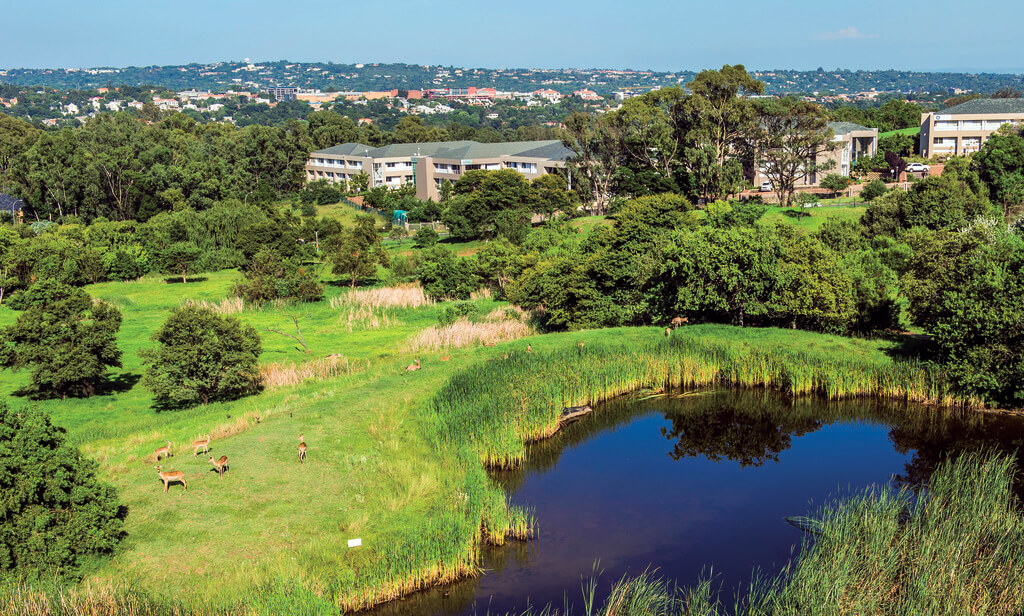
You know how some Americans seem to think we have wildlife on our doorstep? We-ell, they’re not entirely wrong…
The Tryst is located in the Woodlands Office Park, a space with free-roaming, indigenous wildlife.
We chatted with Keith Bent, facilities manager at Growthpoint Properties, and Dr Greenberg of the Wendywood Veterinary Hospital, about how this unique office park came about.
The Woodlands Office Park is home to about 40 buck – a variety of impala, blesbuck and springbuck. When you take your lunch break stroll or do your Park Run, you can spot these antelope as well as leopard tortoises, dassies, squirrels, black-headed and grey herons, malachite kingfishers, woodland kingfishers, spoonbills, hammerkops, frogs, toads, crabs… oh, and never mind the tens of thousands of fish in the dam.
In the last few years, Growthpoint’s also outfitted an apiary, bat boxes and owl boxes in the park.
Keith Bent, Growthpoint Facilities Manager at The Woodlands Office Park
Managing the park is not a walk in the – well, you know. Keith works closely with a game manager and Dr Greenberg, among others, to make sure that the flora and fauna are happy and healthy. One of the ways they do this is to swap out male and female antelope with ones from other game parks. That way, the gene pool stays strong. (Fact: Dr Greenberg explains that this process is taken very seriously in South Africa and gene testing’s done to ensure that inbreeding doesn’t happen. Follow-up fact: one of the signs of inbreeding is crooked horns.)
Origin story
How did it all begin?
A true nature enthusiast, Dr Greenerg (a major driving force behind this unique space), explains how the Stubbs family bought the property for the equivalent of R2,50 after WWI and then sold it in 1990 for roughly R2mil (Not too shabby, Nige).
9 years later and he started working with Paul van der Walt of AECI because, as he says, “Paul had a vision of creating an indigenous wildlife office park.”
Dr Greenberg
Since then (23 years and counting), the team has been “trying to do everything possible to make it an indigenous environment,” says Dr Greenberg.
Talk about a legacy!
Heroes in the heuristic process
Over the decades, the team has introduced many animals: some, like the dassies and blesbuck, now call Woodlands their home. Others, like zebra and duiker, did not end up being the right fit. In the duiker’s case, “they all seemed to escape… they ended up in nearby offices and we had to then capture them and relocate them elsewhere,” says Dr Greenberg. (We’re picturing a duiker sitting at a desk in front of a computer and wondering if anything cuter exists.)
But not only has wildlife been carefully introduced into the area, Dr Greenberg explains that Woodlands has attracted other animals, like “mongoose, hedgehogs, terrapins” and peacocks. This is because of the team’s 20-year effort to transform Woodland’s plant life into being as indigenous as possible.
Dr Greenberg
A taste for the “exotic”
Not everything is indigenous at Woodlands. Part of why it can boast so many antelope is because they eat Kikuyu, which is indigenous to Kenya but not to the Johannesburg highveld. This has caused some controversy among nature conservationists – it’s even been suggested that the Kikuyu should be replaced with buffalo grass and the wildlife with cattle.
The reality is that the Kikuyu affords the park “a carrying capacity,” says Dr Greenberg: if the antelope did feed on buffalo grass, there would only be about 3 of each species in total. Furthermore, the antelope go nuts for the Kikuyu. The team’s discovered that “not only are the antelope thriving here, but they are breeding all year.”
Listen, cows are cute… but do we need more of them? There’s something really magical about being close to wildlife like antelope.
“Doctor Springbok’s in”
Woodlands is kind of famous – and for all the right reasons. Dr Greenberg presented a “talk and paper on [it] at the International Association of Human-Animal Interaction” European conference in 1995. In his presentation, Dr Greenberg showed how “having indigenous animals in an office park has not only an aesthetic value, but it allows indigenous species to survive, and it has a therapeutic effect for the tenants.”
We couldn’t agree more. Because we’ve had those lunch break strolls in the sun gazing at gorgeous wildlife.
Like this article? Share this post far and wide…